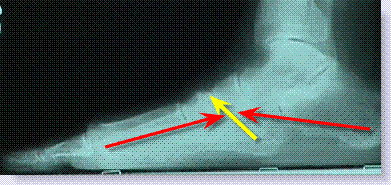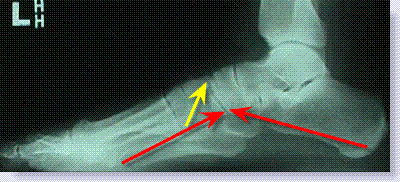midtarsal fault and nerve entrapment
AUTHOR: Marc Mitnick DPM home --> midtarsal faultWHAT IS A MIDTARSAL FAULT
This is a fairly common condition of the foot. It is basically an arthritic spurring on the top of the foot due to a foot that is flattening out too much. Much like tires on a car that will wear out sooner if they are not properly balanced, a foot that is not properly “balanced” will also begin to breakdown much sooner than other parts of the body.
This type of arthritic degeneration is generally, but not always caused by excessive pronation or over-flattening of the foot. As the arch collapses it causes a jamming of the foot bones on the top of the foot and eventually the bones will begin to form bone spurring as a result of the constant pressure of the two bones against each other.
The best way to describe a midtarsal fault is to look at the two x-rays below. These x-rays are not of the same person and the red arrows are “embellished” to prove a point. But lets make believe they are the same person with the top x-ray being a recent x-ray, while the bottom x-ray is from 25 years earlier.
Looking at the first x-ray notice where the yellow arrow is pointing. Even to the untrained eye you can see irregularity in the bones at the very top of the foot. Also, notice the angle formed by the two red arrows.

|
Compare those findings to the second x-ray. Looking at the top of the x-ray you can see how much smoother the bones appear compared to the first x-ray. More importantly, look at the angle formed by the tips of the red arrows. It is a much more acute angle than the first x-ray.

|
In both x-rays the point where the tips of the two red arrows come together represent the highest point of the arch. So, over the years as the arch continually collapses in every day walking there is continual jamming of the bones on top of the foot. Eventually, the daily jamming causes spur formation on the top of the foot (top x-ray).
midtarsal fault pain
A patient will usually come into the office complaining of pain on top of the foot, there is no history of trauma. Many times they will complain that the pain is worse when they are barefoot or in flimsy type shoes and the foot will feel better when they are in sneakers. There are those that will state that in shoes they may also experience a tingling type pain in the area, which in many cases will extend down between the first and second toes.
What is happening is two-fold. One, as the patient walks and the two bones keep jamming into each other, pain ensues. Since there is now spurring and bone growth irregularity, the pain becomes an ongoing saga.
Secondly, as luck would have it there is a cutaneous nerve (superficial nerve) that runs right over the bony prominence. Every time the patient wears a shoe, the top of the shoe presses the nerve into the irregular bony prominences and the tingling or irritation from the nerve begins.
To see if your nerve is involved, with one finger, tap the most painful area and see if you get a tingling pain that travels down to the area between your first and second toe. This is known as a positive Tinel's sign and indicates a nerve entrapment.
Many patients will find that even if they are not walking, they can press on the area and it will hurt quite a bit.
TREATING MIDTARSAL FAULT
conservative care
As mentioned earlier, sometimes just eliminating the shoes that seem to aggravate the condition, avoid going barefoot too frequently, and taking some anti-inflammatory medication for a short duration will solve the pain associated with a midtarsal fault, at least for the short term. Along with that you may also want to try an arch support to support the arch and keep if from flattening out and avoid the bone-to-bone pressure.
If your symptoms are more nerve oriented than bone pain, wearing a doughnut pad with the center placed over the center point of nerve irritation will go a long way in reducing shoe pressure against the nerve and over time should improve your symptoms.
medical care
Midtarsal fault prescription orthotics- If conservative care does not work it is time for medical attention. It is imperative to alleviate the underlying cause, which is the over-flattening of the foot. That part is usually addressed through the use of an orthotic which needs to be worn all the time. It is also worth noting that when wearing an orthotic you must wear shoes that accommodate both the orthotic and your foot. If the shoe is too shallow from top to bottom then the raising of the arch through the use of the orthotic may actually creating more pressure from the shoe pressing on top of the foot. A deep seated shoe is usually necessary.
Prescription anti-inflammatory medication may or may not work better than what you are presently taking. Keep in mind, the reason there are so many anti-inflammatories on the market is because they all do not work on every individual.
Cortisone injections can be very helpful for a midtarsal fault particularly if the superficial nerve is entrapped in the area and is inflamed.
Physical therapy for a midtarsal fault may also help, but again, it is important to note that the underlying pronation has to be adequately addressed in order to have sustained relief.
surgical care
When conservative measures for a midtarsal fault fail, it is time to consider surgical intervention. There are a few different techniques available, but basically the goal of surgery is to remove the bone spurs and free the nerve from any fibrous tissue that may have surrounded it from all the inflammation. The surgery is a simple out-patient procedure.
when pain on top of the foot is not midtarsal fault
Although not frequent, there are times when pain on top of the foot may be something other then bone, tendon, or nerve pain. That leaves arterial pain.
Apparently there was an incident in Australia where a woman presented with a complaint of pain and swelling on the top of both her feet. Her medical history was unremarkable other then the fact that she routinely wore sandals with tight straps that cut across the tops of her feet.
X-rays revealed a midtarsal exostosis of the cuneiform bones. She also exhibited palpable pulses. She underwent an ultrasound which confirmed bilateral aneurysms of the dorsal pedis artery, which is the artery that travels down the top of the foot.
The patient had both aneurysms surgically excised and replace with a graft from her saphenous vein. Both excised aneurysms exhibited atherosclerosis in spite of the fact that the woman had no risk factors for cardiovascular disease.
The origin of this problem is thought to be due to compression of the dorsalis pedis arteries between the cuneiform bone spurs and the tight straps of her sandals occurring on a repeated basis.(1)
This of course begs the question, every time someone presents to the office with midtarsal fault pain, do we have to rule out dorsalis pedis aneurysm? Aneurysms have the potential to cause thrombosis and embolism which can have serious consequences. From a practical standpoint there are very few reported cases, but does the onset of neuritis pain or bone pain both seen in midtarsal faults alert us to make shoe changes in order to avoid damage to the arteries?
(1) "Sandal Strap" Trauma and Atherosclerosis Are Dual Pathologies Leading to Bilateral True Aneurysms of the Dorsalis Pedis Arteries; Sonntag M, Hopper N, Graham AR, (St. Vincent's Hospital, Darlinghurst, Australia; Prince of Wales Hospital, Sydney, Australia: St. Vincent's Clinic, Darlinghurst, Australia)
J Vasc Surg. 2013 May:57(5):1391-1394
REFERENCES
Want more information? CLICK HERE


Recent Articles
-
Vitamin D impact on health
Feb 06, 23 07:17 PM
Researchers are suggesting that the effectiveness of Vitamin D in fighting and preventing disease is predicated on a persons body mass index (BMI). The thinner the person the greater the positive impa… -
Foods to speed up healing
Feb 01, 23 02:41 PM
One of the best ways to help yourself heal faster after surgery is to eat well. Getting the proper nutrition will provide your body with the essentials it needs to promote healing. Here is a suggestio… -
Cancer and Type 2 Diabetes
Jan 25, 23 04:52 PM
An article revealing that older type 2 diabetics have a higher incidence of cancer then non-diabetics. It is suggested that cancer may surpass CVD as the number one cause of death in older diabetics. -
Does glucosamine or MSM reduce arthritis pain?
Jan 22, 23 01:41 PM
A good review of the possible benefits to taking glucosamine, chondroitin or MSM for arthritis. Always beware of the possible side effects of over the counter supplements. -
shin splints
Jan 18, 23 05:12 PM
A great review on the various causes of shin splints, along with treatment options. -
Whats new in skin cancer?
Jan 15, 23 08:32 PM
A presentation of newer skin protection combinations in an effort to better protect the skin from the hazards of sun exposure. -
Causes and risk factors of warts
Jan 14, 23 05:02 PM
A good review of the causes of warts and protective measures you can take to prevent developing them. -
Do chronic wounds need to be dressed daily?
Jan 11, 23 02:18 PM
Because of supply chain shortages as well as staffing shortages particularly during the pandemic, many institutions extended the time between dressing changes for chronic wounds. Is this really the be… -
Food choices that raise your risk of type 2 diabetes
Jan 08, 23 10:07 AM
A good review of how blood sugars can become elevated and the harm that can do. Certain food groups have a tendency to raise your blood sugars and should be avoided. -
Outcome stats from Scarf bunionectomy
Jan 03, 23 03:04 PM
The Journal of Foot and Ankle Surgery recently reported a meta analysis of outcomes in 1583 Scarf bunionectomies that met their inclusion criteria. Adverse events did not seem to be any better or wors…